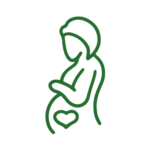WHAT IS IT?
Fibrocystic breasts refer to breasts that are composed of tissue that feels lumpy or ropelike in texture. The condition is common. More than half of women — mainly those in their 20s to 50s — experience fibrocystic breast changes at some point in their lives.
Fibrocystic breasts can cause breast pain, tenderness and lumpiness — especially in the upper, outer area of your breasts. Symptoms tend to be most bothersome just before menstruation.
SYMPTOMS may include:
- Breast lumps or areas of thickening that tend to blend into the surrounding breast tissue
- Generalized breast pain or tenderness
- Breast lumps that fluctuate in size
- The monthly increase in breast pain or lumpiness from midcycle to just before your period
- Changes that occur in both breasts, rather than just one
- Green or dark brown non-bloody nipple discharge that may leak without pressure or squeezing
The exact cause of fibrocystic breast changes isn’t known, but experts suspect that reproductive hormones — especially estrogen — play a role. Hormone fluctuationsmay cause your breasts to develop lumpy areas that feel tender, sore, and swollen. The pain and lumpiness tend to clear up once your period begins.
WHAT TESTS TO EXPECT
To evaluate your condition, your doctor will likely perform a breast exam, examining your breast for areas of thickening, lumps, and cysts associated with fibrocystic breasts. You may undergo additional tests to rule out other possible causes, including:
- Mammogram. If your doctor detects a breast lump or unusual thickening in your breast tissue, you have a mammogram to evaluate the area and rule out a cancerous tumor.
- Ultrasound. Women younger than age 30 might have an ultrasound exam instead of, or in addition to, a mammogram. Ultrasound can better evaluate dense breast tissue, which is more common in younger women than older women. Ultrasound can also help distinguish between fluid-filled breast cysts and solid masses. Other imaging procedures also may be performed.
- Fine-needle aspiration. If your doctor thinks the lump detected on the clinical exam has the consistency of a cyst, he or she may order an ultrasound to confirm the presence of a cyst and then attempt to draw fluid from the cyst using a very fine needle.
- Breast biopsy. A small sample of breast tissue is removed from the suspicious area for microscopic analysis. A breast biopsy is generally performed when it’s unclear if a lump or area of thickening seen during an imaging exam is benign or cancerous.
TREATMENT
If you don’t experience symptoms or if your symptoms are mild, no treatment may be needed. Severe pain or large, painful cysts associated with fibrocystic breasts may warrant treatment.
Breast cysts
Options for treating painful cysts include:
Fine-needle aspiration. Your doctor uses a hair-thin needle to drain the fluid from the cyst. Removing the fluid confirms that the lump is a breast cyst, not a solid mass. Removal of fluid also relieves the discomfort caused by the cyst.
Surgical excision. Rarely, surgery is needed to remove a persistent cyst-like lump that doesn’t resolve after other treatments.
Breast pain
To treat breast pain your doctor may recommend: Over-the-counter pain relievers, Oral contraceptives lower the levels of cycle-related hormones linked to fibrocystic breast changes.
LIFESTYLE
- Wear a firm support bra. Try to buy one fitted by a professional. Wear a sports bra when exercising and even when sleeping.
- Limit or avoid caffeine. Studies of caffeine’s effect on breast pain are inconclusive, but some women find limiting caffeine helpful.
- Decrease the fat in your diet. Reduced-fat may decrease breast pain or discomfort associated with fibrocystic breasts.
- Use a heating pad or warm water bottle. Apply it to painful areas to relieve your discomfort.
For women, it is necessary to conduct periodic checking of all vitals.
Excerpt From: The Mayo Clinic. “Mayo Clinic A to Z Health Guide”.






































































